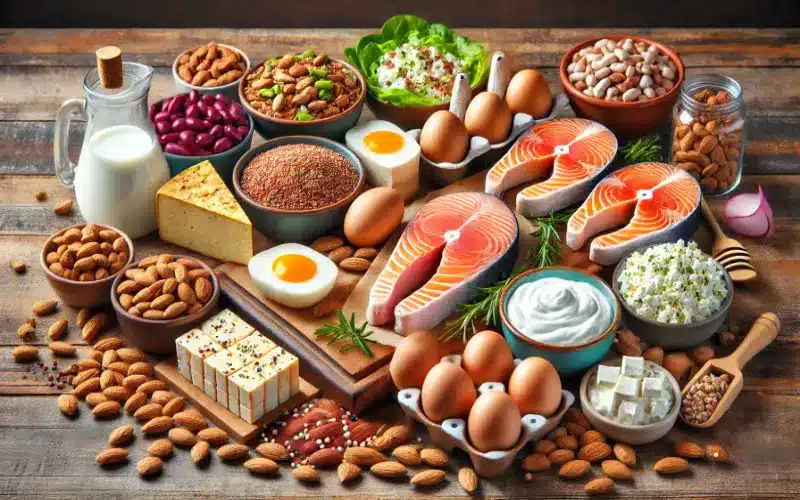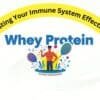High protein diets are crucial for those aiming to gain weight, particularly in the form of muscle mass. Protein is a macronutrient that provides the building blocks necessary for muscle repair and growth. Understanding how to effectively incorporate high protein foods into your diet can make a significant difference in your weight gain journey.
The Science Behind Protein and Muscle Growth
Proteins are composed of amino acids, which play a vital role in muscle repair and growth. When you engage in resistance training or other forms of exercise, your muscle fibers experience microscopic tears. Consuming protein helps to repair these tears, leading to increased muscle mass over time.
Moreover, the type and timing of protein intake can significantly influence muscle growth. Branched-chain amino acids (BCAAs), particularly leucine, are critical in initiating the muscle protein synthesis process. This underscores the value of consuming complete protein sources that contain all essential amino acids.
Boost your gains with our premium weight gainer—try it now!

Top High Protein Foods to Include in Your Diet

Incorporating a variety of high protein foods is essential for a balanced diet.
Lean meats
Lean meats such as chicken breast and turkey are excellent sources of protein. They are not only rich in protein but also low in fat, making them ideal for muscle building without adding excessive calories.
Chicken breast
For instance, provides approximately 31 grams of protein per 100 grams, while being virtually free of carbohydrates and fats. This makes it an optimal choice for those looking to gain lean muscle.
Turkey
In particular, turkey breast is similarly beneficial, offering about 29 grams of protein per 100 grams. These meats are also versatile, easily incorporated into various dishes from salads to stir-fries.
Fish
Fish, especially salmon and tuna, offer not only protein but also beneficial omega-3 fatty acids. These fatty acids support heart health and reduce inflammation, which can enhance recovery and muscle growth.
Salmon
It is particularly notable, providing around 25 grams of protein and a significant amount of omega-3s per 100 grams. ‘
Tuna
Tuna offers a higher protein content at about 30 grams per 100 grams, with minimal fat. Including these animal-based proteins ensures a comprehensive intake of essential amino acids, which are crucial for muscle protein synthesis and overall metabolic health. Regular consumption of these fish can also support cognitive function and reduce the risk of chronic diseases.
Dairy products
Dairy products like Greek yogurt and cottage cheese provide a convenient protein boost.
Greek yogurt
In particular, is packed with protein and probiotics, supporting both muscle growth and gut health. A typical serving of Greek yogurt can provide up to 20 grams of protein, making it an excellent snack or addition to meals. The probiotics in Greek yogurt also promote a healthy gut microbiome, which is essential for nutrient absorption and overall health.
Cottage cheese
It contains casein protein, which digests slowly and provides a sustained release of amino acids, making it an excellent option for nighttime consumption. A single cup of cottage cheese can offer around 28 grams of protein, along with calcium and other vital nutrients.
Legumes
including lentils and chickpeas, are great plant-based protein sources.
- Lentils provide approximately 18 grams of protein per cooked cup, along with significant amounts of fiber, iron, and folate.
- Chickpeas offer a similar protein content, with about 15 grams per cooked cup. These legumes are also rich in fiber and other essential nutrients, contributing to overall health. The fiber in legumes supports digestive health and can help regulate blood sugar levels, making them a valuable addition to a balanced diet. Additionally, legumes are highly versatile and can be used in soups, salads, and various vegetarian dishes.
Nuts and Seeds
Such as almonds and chia seeds, are also valuable additions.
- Almonds provide around 21 grams of protein per 100 grams, along with healthy fats, vitamin E, and magnesium. These nutrients support heart health, bone health, and energy production.
- Chia seeds offer a unique profile, with approximately 17 grams of protein per 100 grams, along with omega-3 fatty acids, fiber, and antioxidants. They provide healthy fats, which are crucial for hormone production and overall energy levels. These foods not only support muscle growth but also contribute to a balanced and nutritious diet. Including a handful of nuts or seeds in your meals can enhance their nutritional value and provide sustained energy throughout the day.
The Role of Protein Supplements

While whole foods should be the foundation of your diet, protein supplements can be a practical addition. Whey protein, derived from milk, is a popular choice due to its high biological value and rapid absorption rate. It contains all essential amino acids and is particularly rich in branched-chain amino acids (BCAAs), which are critical for muscle growth. Whey protein is ideal for post-workout consumption, as it quickly delivers amino acids to muscle tissues, enhancing recovery and promoting muscle hypertrophy.
Casein protein is another milk-derived option, which digests more slowly, providing a sustained release of amino acids. This makes it an excellent choice for a nighttime protein source, ensuring a steady supply of nutrients to muscles during sleep, a crucial period for muscle repair and growth.
For those avoiding animal products, plant-based protein powders such as pea and hemp protein are excellent alternatives. These plant-based options can offer a comparable protein content to animal-derived proteins and are often enriched with additional vitamins and minerals. Incorporating protein supplements can help meet daily protein requirements, especially for those with high protein needs or limited access to high-protein foods.
Timing and Frequency of Protein Consumption
The timing of protein intake can influence muscle growth. Consuming protein-rich meals or snacks within 30 minutes to 2 hours post-exercise is beneficial for muscle recovery. This period, often referred to as the anabolic window, is when the muscles are most receptive to nutrients. During this time, protein consumption can significantly enhance muscle protein synthesis, aiding in quicker recovery and greater muscle gains. Incorporating easily digestible proteins, such as whey, during this window can optimize these benefits.
Distributing protein intake evenly throughout the day, with 20-30 grams per meal, ensures a constant supply of amino acids, optimizing muscle synthesis. Rather than consuming a large amount of protein in one or two meals, spreading intake across multiple meals can maintain a more stable muscle protein synthesis rate. This approach supports continuous muscle repair and growth, making it more effective than sporadic protein consumption.
Combining Protein with Other Macronutrients
Balancing protein intake with carbohydrates and fats is crucial for overall nutrition. Carbohydrates provide the energy needed for workouts and recovery. Consuming carbohydrates alongside protein can replenish glycogen stores, enhancing recovery and performance in subsequent workouts.
Complex carbohydrates, such as whole grains, vegetables, and legumes, offer sustained energy release, stabilizing blood sugar levels and supporting prolonged physical activity. Combining protein with complex carbohydrates in meals ensures a steady energy supply, which is essential for both muscle building and overall health.
Fats support hormone production and overall health.
- Healthy fats, such as those found in avocados, nuts, seeds, and olive oil, are vital for maintaining hormonal balance, which is crucial for muscle growth and overall well-being.
- Dietary fats also aid in the absorption of fat-soluble vitamins (A, D, E, and K), which are important for various bodily functions, including immune support and bone health.
Combining protein with healthy fats in meals enhances nutrient absorption and provides a balanced approach to weight gain. For example, pairing grilled chicken (protein) with quinoa (complex carbohydrates) and avocado (healthy fats) creates a nutrient-dense meal that supports muscle growth, energy levels, and overall health.
Meal Planning and Preparation Tips

Effective meal planning and preparation can streamline your high protein diet. Preparing meals in advance ensures you have convenient, protein-rich options readily available. This reduces the temptation to opt for less nutritious, quick-fix foods.
Batch cooking and Portioning
Techniques such as batch cooking and portioning meals can save time and help maintain dietary consistency. For instance, cooking a large batch of quinoa, grilling several chicken breasts, and roasting a variety of vegetables can provide the components for several meals throughout the week. Storing these components in portioned containers makes it easy to assemble balanced, protein-rich meals quickly.
Experimenting
Different recipes and flavors keeps your diet enjoyable and sustainable. Incorporating a variety of herbs, spices, and cooking methods can transform simple ingredients into exciting meals. Trying new recipes can also introduce you to different high protein foods and combinations, preventing dietary monotony and promoting long-term adherence.
Planning meals
Looking forward to eating can make sticking to a high protein diet feel less like a chore and more like a pleasurable aspect of your routine. This not only enhances your nutritional intake but also supports your overall lifestyle and fitness goals.
High-Calorie Protein Snacks for Weight Gain
Snacking smartly is a highly effective strategy for those aiming to increase their protein and calorie intake throughout the day. High-protein, calorie-dense snacks ensure you’re consistently fueling your body for muscle repair and growth—especially between main meals.
Nut Butters
Nut butters like peanut and almond butter are rich in protein and healthy fats. Spreading them on whole-grain toast or pairing with bananas makes a simple yet calorie-dense snack perfect for muscle gain.
Trail Mix
Homemade trail mix consisting of mixed nuts, seeds, and dried fruits is not only high in protein but also a great source of omega-3s and antioxidants. It’s easy to carry and perfect for on-the-go snacking.
Protein Bars
Look for bars with at least 15–20 grams of protein and minimal added sugars. You can also make your own using oats, protein powder, and nut butter to tailor the nutritional profile to your needs.
Full-Fat Dairy Snacks
Options like full-fat Greek yogurt, cheese sticks, and whole milk smoothies offer a powerful combination of protein and calories. Pairing yogurt with honey or granola adds extra energy and taste.
Hard-Boiled Eggs
Eggs are a complete protein source. Boiled eggs are a portable snack that offers about 6 grams of high-quality protein each, along with healthy fats and essential vitamins.
Sample 3,000-Calorie Meal Plan for Muscle Gain
A structured meal plan helps you stay on track with your weight gain goals. Below is a sample daily meal plan providing approximately 3,000 calories and a balanced ratio of protein, carbs, and fats to support lean mass growth.
Breakfast
- 3 scrambled eggs with shredded cheese
- 2 slices of whole-grain toast with peanut butter
- 1 banana
- 1 glass of whole milk
Mid-Morning Snack
- 1 cup Greek yogurt with mixed berries and honey
- 1 handful of almonds
Lunch
- Grilled chicken breast (150g)
- 1 cup cooked quinoa
- Steamed broccoli and carrots
- 1 tbsp olive oil drizzled for healthy fats
Afternoon Snack
- Whey protein shake blended with milk, oats, peanut butter, and dates
Dinner
- Baked salmon (150g)
- 1 cup brown rice
- Mixed salad with avocado and olive oil dressing
Evening Snack
- 1 cup cottage cheese
- 1 tbsp chia seeds
- 1 sliced apple
This kind of plan ensures consistent protein intake throughout the day, supports glycogen replenishment, and provides enough energy to fuel workouts and recovery.
Addressing Common Challenges in High-Protein Diets

While a high-protein diet is beneficial for muscle gain, it can also come with challenges. Recognizing and overcoming these can improve consistency and results.
Digestive Discomfort: A sudden spike in protein intake may cause bloating or gas. Start gradually and include fiber-rich foods to support digestion. Opt for easily digestible protein sources like whey isolate or eggs.
Budget Constraints: Protein-rich diets can seem expensive. Budget-friendly options like lentils, eggs, canned tuna, and chickpeas offer excellent nutrition at a low cost. Buying in bulk or cooking at home also helps manage expenses.
Dietary Restrictions: Vegetarians and vegans can face difficulties with protein intake. Incorporating plant-based proteins such as tofu, tempeh, lentils, and protein-fortified alternatives like pea or soy protein powders can bridge the gap.Reduced Appetite:Protein can suppress appetite, which might be a hurdle for those needing to consume more calories. Opt for liquid meals like milk-based protein shakes, or eat smaller, more frequent meals to hit calorie goals without feeling too full.
Conclusion
Incorporating high protein foods into your diet is a strategic approach to achieving weight gain goals. By understanding the science behind protein and muscle growth, you can make informed choices about your dietary intake. Selecting diverse protein sources, from lean meats and fish to dairy, legumes, nuts, and seeds, ensures a comprehensive nutrient profile. This variety not only supports muscle growth but also enhances overall health and dietary satisfaction.
Effective meal planning and preparation can streamline your high protein diet, making it easier to maintain consistency and achieve your weight gain goals. With careful planning and mindful eating, you’ll be on the path to a healthier, stronger physique, reaping the benefits of a well-rounded, protein-rich diet tailored to your specific needs.










Leave a reply
You must be logged in to post a comment.